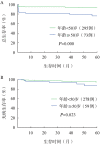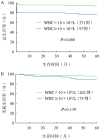[Analysis of early death factors and prognosis of acute promyelocytic leukemia]
- PMID: 33445851
- PMCID: PMC7840560
- DOI: 10.3760/cma.j.issn.0253-2727.2020.12.010
[Analysis of early death factors and prognosis of acute promyelocytic leukemia]
Abstract
Objective: To summarize the clinical characteristics of an early death in patients with de novo acute promyelocytic leukemia (APL) , analyze the risk factors and direct causes of early death, and perform survival analysis. Methods: The clinical data of 368 patients with de novo APL in three centers (First Affiliated Hospital of Soochow University, Soochow Guangci Hospital, and Soochow Hopes Hospital of Hematology) during January 2011-December 2017 were retrospectively analyzed. The clinical characteristics of patients who suffered hemorrhagic early death and non-hemorrhagic early death were compared. The risk factors for early death, survival, and prognosis of patients with APL were analyzed. Results: Among the 368 de novo APL patients, 31 died early with an early mortality rate of 8.4%. The median time from diagnosis to death was 7 (0-29) d. On comparison of the clinical characteristics of patients with early death and non-early death and subsequent multivariate analysis using a logistic regression model, it was observed that age ≥50 years and WBC ≥10×10(9)/L were independent risk factors for early death (P<0.01) . A total of 27 (87.1%) of the 31 early deaths was directly attributed to hemorrhage as the immediate cause of early death. Hemorrhage was the only cause of death in patients <50 years old and the major cause of death in patients ≥50 years old. A comparison of the clinical characteristics of patients with hemorrhagic early death and patients with non-hemorrhagic early death suggested that the median age and indirect bilirubin concentration of patients with hemorrhagic early death were lower than those with non-hemorrhagic early death (P<0.05) . The median follow-up time for all patients was 41.0 (0.3-101.4) months. The 2-year overall survival (OS) rate was (93.5±1.3) %, and the 5-year OS rate was (91.0±1.5) %. The 2-year disease-free survival (DFS) rate was (98.8±0.6) %, and the 5-year DFS rate was (97.1±0.9) %. The 2-year OS rate of patients ≥50 years old and patients <50 years old was 79.3% vs 94.2%, P=0.000; the 2-year DFS rate was 92.3% vs 98.1%, P=0.023. The respective 2-year OS rates of high-risk and non-high-risk patients were 77.3% and 96.7% (P=0.000) and the respective 2-year DFS rates were 94.0% and 98.4% (P=0.139) . Conclusion: Age and WBC are independent prognostic factors for early death. We observed a difference in early mortality between high-risk and low-risk APL, but no difference in DFS rate.
目的: 总结初诊急性早幼粒细胞白血病(APL)早期死亡患者的临床特征,分析早期死亡的危险因素和直接死亡原因,同时对患者进行生存分析。 方法: 回顾性分析2011年1月至2017年12月苏州大学附属第一医院、苏州大学附属第一医院广慈分院、苏州弘慈血液病医院收治的368例初诊APL患者的临床特征,分析早期死亡的独立危险因素,比较出血性早期死亡与非出血性早期死亡患者的临床特征,并对所有APL患者进行生存分析。 结果: 368例初诊APL患者中早期死亡31例,早期病死率为8.4%,从诊断至死亡的中位时间为7(0~29)d。比较早期死亡患者与非早期死亡患者的临床特征,应用Logistic回归模型进行多因素分析显示,年龄≥50岁和初诊时WBC≥10×10(9)/L为初诊APL患者发生早期死亡的独立危险因素(P值均<0.01)。31例早期死亡患者中有27例(87.1%)的直接死亡原因为出血,出血是<50岁患者的唯一死亡原因,≥50岁患者的主要死亡原因。比较出血性早期死亡患者与非出血性早期死亡患者的临床特征,提示出血性早期死亡患者的中位年龄和间接胆红素水平较非出血性早期死亡患者低(P<0.05)。所有患者中位随访时间为41.0(0.3~101.4)个月。2年总生存(OS)率为(93.5±1.3)%,5年OS率为(91.0±1.5)%。2年无病生存(DFS)率为(98.8±0.6)%,5年DFS率为(97.1±0.9)%。≥50岁与<50岁患者的2年OS率分别为79.3%和94.2%(P=0.000);2年DFS率分别为92.3%和98.1%(P=0.023)。高危患者与非高危患者的2年OS率分别为77.3%和96.7%(P=0.000);2年DFS率分别为94.0%和98.4%(P=0.139)。 结论: 年龄≥50岁和WBC≥10×10(9)/L是APL患者早期死亡的独立危险因素;高危和低危APL的早期病死率有差异而DFS率差异无统计学意义。.
Keywords: Early death; Elderly; High risk; Leukemia, acute, promyelocytic.
Figures
Similar articles
-
Effects of peripheral blood leukocyte count and tumor necrosis factor-alpha on early death in acute promyelocytic leukemia.BMC Cancer. 2023 Jan 7;23(1):27. doi: 10.1186/s12885-022-10499-2. BMC Cancer. 2023. PMID: 36611025 Free PMC article.
-
Gene mutations in acute promyelocytic leukemia early death in patients treated with arsenic trioxide alone.Clin Transl Oncol. 2021 Oct;23(10):2171-2180. doi: 10.1007/s12094-021-02625-6. Epub 2021 May 3. Clin Transl Oncol. 2021. PMID: 33942222
-
Does leukocytosis remain a predictive factor for survival outcomes in patients with acute promyelocytic leukemia receiving ATRA plus a chemotherapy-based regimen? A prospective multicenter analysis from TALWG.Hematology. 2023 Dec;28(1):2191462. doi: 10.1080/16078454.2023.2191462. Hematology. 2023. PMID: 36951362
-
[Clinical features and prognostic analysis of high-risk acute promyelocytic leukemia patients].Zhonghua Xue Ye Xue Za Zhi. 2016 May 14;37(5):360-5. doi: 10.3760/cma.j.issn.0253-2727.2016.05.002. Zhonghua Xue Ye Xue Za Zhi. 2016. PMID: 27210868 Free PMC article. Chinese.
-
Thrombo-hemorrhagic deaths in acute promyelocytic leukemia.Thromb Res. 2014 May;133 Suppl 2:S112-6. doi: 10.1016/S0049-3848(14)50019-9. Thromb Res. 2014. PMID: 24862130 Review.
Cited by
-
Clinical characteristics and analysis of related factors associated with early death in newly diagnosed patients with acute promyelocytic leukemia.Discov Oncol. 2024 Aug 27;15(1):375. doi: 10.1007/s12672-024-01241-4. Discov Oncol. 2024. PMID: 39192064 Free PMC article.
-
Predictors of early death and clinical features in newly diagnosed patients with low-intermediate risk acute promyelocytic leukemia.Front Oncol. 2022 Sep 14;12:895777. doi: 10.3389/fonc.2022.895777. eCollection 2022. Front Oncol. 2022. PMID: 36185183 Free PMC article.
-
Effects of peripheral blood leukocyte count and tumor necrosis factor-alpha on early death in acute promyelocytic leukemia.BMC Cancer. 2023 Jan 7;23(1):27. doi: 10.1186/s12885-022-10499-2. BMC Cancer. 2023. PMID: 36611025 Free PMC article.
-
Clinical analysis of ten cases of HIV infection combined with acute leukemia.Open Med (Wars). 2025 Feb 24;20(1):20241081. doi: 10.1515/med-2024-1081. eCollection 2025. Open Med (Wars). 2025. PMID: 40028267 Free PMC article.




